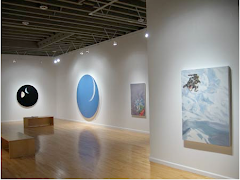In a famous essay on Sol LeWitt, rock star critic Rosalind Krauss argues that Lewitt’s work is often misunderstood as embodiments of rational thought. According to Krauss, LeWitt’s desire to carry out and exhaust the overwhelming abundance of his dryer-than-ice variations is an exceedingly bent ambition. Although there is a distinct sense of logic to drawing all of the possible permutations that a cube will allot, the urge to do so is relatively mental. I couldn’t help thinking of that old Krauss paper as I wandered through John Eisler’s recent exhibition We Want Your Complex at Diaz Contemporary. But if a bent logic informs LeWitt’s formalism, then Eisler’s is truly perverse. Every aesthetic decision that Eisler makes is absurd, exaggerated and displayed. These works not only bear the scars of his wonky array of semi-masochistic aesthetic procedures, they are the scars: the fossilized remains of his tortured materials.
Before I go on, we should all take a moment to feel sorry for Mr. Diaz’s poor gallery space: his lovely white cube has been rammed and crammed with work. The floor is covered, wall-to-wall, in silver, triangular shards of reflective mylar, like a giant disco-ball disassembled and lay flat. The walls are filled with large-scale brightly hued canvases, and even the windowsills have works (stained plexi-glass squares) resting on their ledges.
The paintings in this exhibition are stained on both sides, creating an effect that bears as much similarity to Grateful Dead t-shirts as to Colour Field painting. Created in section by folding and stretching segments to a tabletop, their surfaces are littered with staple-inflicted puncture wounds that create crisscrossing lines across the picture plane. Triangular forms are painted on the surface in high-intensity, straight-out-of-the-tube colours, like shards of light reflecting from a dangling-prism style chandelier (or from the gallery floor). Frayed edges of his pictures raw canvas are folded back over the side of the stretcher frame with threads dangling like cobwebs in a horror show.
The overall effect of the installation is remarkably disorientating as Eisler’s maxi-minimal aesthetic overwhelms our retinal registry with vast quantities of sparse forms in assaulting, psychedelic colours. We Want Your Complex is a twisted reworking of Modernist values and concepts. These formalist objects are pushed to their decorative limits, transforming the lofty goals of “High” Modernism into an amusement park fun house. Somewhere the ghosts of Adolph Loos, Alfred Barr and Clement Greenberg are really not amused.

video footage from Sudden Frost at Elissa Cristall, Vancouver
Will Gorlitz at Michael Gibson Gallery

John Eisler at Diaz Contemporary

Michel Daigneault at AKAU

No comments:
Post a Comment